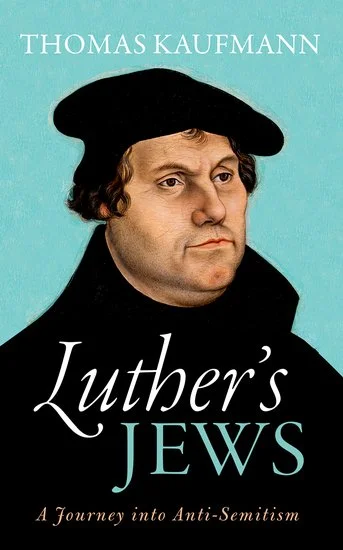Most congregations realize that occasionally they have to set their jaws, tighten their haunches, and listen to a sermon on divorce. It shows up in the three-year lectionary at least once, and while leery pastors might try to sneak around it, both they and their flocks will know, leaving a silence far more awkward than God’s gracious will for marriage and those who fail at it. Better to address the subject than to suggest that we are embarrassed by the good things that our Lord has said…
Review of "Martin Luther's Legacy" by Mark Ellingsen
The subject matter of this book is very dear to my heart. I have spent my academic and pastoral vocations in finding ways to make Luther relevant for our times. Mark Ellingsen’s focus in this book follows in the same path. I am grateful to Ellingsen’s scholarly and pastoral wisdom in reading Luther from a “pastoral-contextual paradigm.” Ellingsen establishes why he prefers to read Luther from a “pastoral-contextual model” rather than reading Luther as a systematic theologian. As the author notes and I agree, to read Luther as a systematic theologian does not do justice to the richness of his thought and the paradoxical character of his theology…
The Eric W. Gritsch Memorial Fund Fellowship for Reformation Studies
Our friends at the Eric W. Gritsch Memorial Fund are offering an excellent fellowship opportunity for a student in the field of Reformation History. The Gritsch Memorial Fund (est. 2013), founded in honor of Reformation Scholar and Lutheran pastor Eric W. Gritsch (1931–2012), is pleased to offer a substantial fellowship award for a scholar pursuing studies in Reformation history and/or theology…
Preaching Law And Gospel In The Old Testament
The law-gospel paradigm is central to Lutheran hermeneutical, catechetical, and homiletical theory and praxis. The Formula of Concord, Solid Declaration devotes all of Article V to this paradigm. It explains that “the law... is a 'ministry that kills by the letter’ and that ‘proclaims condemnation’; the gospel, on the other hand, is ‘the power ofGod for salvation to everyone who has faith." It emphasizes that preaching the law is insufficient for “genuine and salutary repentance,” that the “gospel must be added to it,” and that “both teachings must be alongside each other and must be taught together, but in a proper order and with appropriate distinction”…
The First Martyrs of the Reformation
The story of the first evangelical martyrs is closely related to the story of the Observant Augustinian Monastery at Antwerp. The brief existence of the Antwerp monastery roughly overlaps the first decade of Luther’s tenure at Wittenberg. Established in 1512, the Antwerp monastery was dissolved ten years later, thanks in part to the fact that the brethren there would not stop preaching Luther’s ideas. In 1522, the monastery was vacated and closed for good. In 1528, the monastery’s chapel was reestablished as a Roman Catholic parish church…
The St. Thomas Mass
For years now, the Mikael Agricola Church in Helsinki has been packed every Sunday evening at six o’clock. It is the hour for the St. Thomas Mass, celebrated under the name of the apostle who seemed to have more questions than answers in his faith. This Lutheran worship service has been influenced by old liturgical traditions of the church as well as by the spirit of ecumenism. The service takes two hours and it requires a team of seventy to a hundred people, all volunteers. Usually the teams differ from Sunday to Sunday, because each Sunday is a project of its own…
Review of "Changing World, Changing Christ" by Richard O. Johnson
Most readers of this website’s book reviews probably lean toward a sympathetic view of the American Lutheran Publicity Bureau and its associated journal, Lutheran Forum. I therefore want this review to respect both this readership and the ALPB but also include a historian’s critical eye. I considered this balance when I first picked up Richard O. Johnson’s Changing World, Changeless Christ: The American Lutheran Publicity Bureau, 1914–2014. Thankfully, this volume provides a solid history of the ALPB, which made my balancing act much easier…
The Epistle of Jude, a Christian Midrash
The Letter of Jude has been called “the most neglected book of the New Testament.” Some classical theologians, among them Martin Luther, have held that Jude is not only dependent on but even contained in II Peter. Exegetes still wrestle today with the proper classification of Jude. Is it a “catholic letter,” meaning that it belongs together with I and II Peter and, maybe, the Pastoral Epistles? Or does it rather indicate a proximity to Jewish Christianity, belonging therefore with Matthew and Mark? Is it a “genuine letter,” composed for the purpose of solving a real controversy, or a treatise against heresy in general?…
Adiaphora, Mandata, Damnabilia
Adiaphora is a classy word and antedates the English language by a long time. Twenty-five hundred years ago the philosophical sect of the Sophists talked about adiaphora, and the Cynics did it before them. Diapherein in Greek means to separate, to make a difference. Add the letter alpha (an alpha privative) and it becomes adiapherein. Thus, adiaphora means things that do not make a difference. Or it can mean things that are neither good nor evil. That makes the term a bit too static for good theological use…
I Don’t Want My Church to Grow
The title is an exaggeration. Or, more accurately, a lie. As a Lutheran pastor, I do want my church to grow. If you stripped away all the artifice and false humility and my saying what I think I should say and even trying to think what I should think: yes, I want my church to grow more than anything else.
A Reader's Guide to Bonhoeffer Biographies
When I teach Bonhoeffer seminars at my seminary, I enjoy shocking the students early on by expressing what can only come across as a contrarian’s opinion: “You know, Bonhoeffer’s participation in the plot to kill Hitler was probably the least interesting thing about his life.” The students are generally aghast at this. Surely the romantic image of Bonhoeffer as the courageous Christian resister and martyr is too precious a treasure to diminish in this way? Well, I go on to explain, I say this because, as deeply inspiring as his courage and resistance are, for the contemporary church his theology is an even more exciting contribution…
St. Rosa Young
Rosa Jinsey Young is known as the mother of black Lutheranism in central Alabama, as she singlehandedly brought the Lutheran church to rural Alabama from 1916 onward, establishing churches and schools for underserved black children and families. Her ministry led to the founding of what is now known as Concordia College Alabama in Selma, the only historically black Lutheran college in the nation…
Review of "The Story of the Human Body" by Daniel Lieberman
If an evil super-genius plotted to breed a race of obese, feeble, heart-diseased diabetics, he could hardly do better than to re-create the consumer paradise of twenty-first-century America. From cradle to grave we pass our days largely immobile, gazing at screens and wiggling our fingertips. To fuel this inactivity we devour copious quantities highly processed food, maintaining our metabolisms on ceaseless alert. Our environments are so sanitized of dreaded biological pathogens that our understimulated immune systems attack our own bodies; while in car and home we knowingly inhale a miasma of certified carcinogens against which we have no defense. We bomb the rare infection with such antibiotic force that our indigenous micro-biomes are catastrophically reconfigured, setting off a cascade of ailments only beginning to be understood by science…
The Genesis and Purpose of Year D
The recent publication of the twentieth anniversary edition of the Revised Common Lectionary marks a milestone in ecumenical cooperation on matters liturgical, from which its numerous contributors may rightly derive both hope and satisfaction. For a good many church leaders and laity, the RCL is simply a delightful and enriching tool for exploring Scripture, inspiring mission, and marking time in the life of faith. Such a prolific level of institutionalization or “normalization,” however, begs certain cautions, especially when such usage becomes measurable in decades. The aim of this essay is to enumerate the primary concerns that underlie, give rise to, and in some cases form the main focal points of Year D, my proposed expansion of the lectionary…
How Is Your Revival Going?
A while back I spent some time in Madagascar, teaching a course with my husband at the Lutheran seminary in Fianarantsoa. There were three questions that the students asked us repeatedly….
Review of "Luther's Jews" by Thomas Kaufmann
This book is very painful to read. It is also absolutely necessary. “Luther’s attitude to the Jews, though it makes him incomprehensible, indeed unbearable, to people of our time, is very much of his time” (153). This in brief is Kaufmann’s thesis: that Luther’s anti-Judaism and premodern anti-Semitism is representative, not unique, of the sixteenth-century church—small consolation for Lutherans and Christians. At yet, at the same time, we see in Luther two polarities of thought that are so mutually opposed as to be fundamentally bewildering...
Triduum
In the garden—
amid the grappling
with anguish and silence
—a sound of sounds arising
as if from earth itself
scorning the tumult of the city.
Discern the sounds: mountain
goat bleating her birth; thump
of wild ass and ox; futile beating
of outstretched ostrich wings...
The Confessional Indifference to Altitude
It astounds me that, in the twenty-two years I have shared responsibility for the liturgical formation of seminarians, I have heard Lutherans invoke the terms “high church” and “low church” as if they actually describe with clarity ministerial positions regarding worship. It is assumed that I am “high church” because I teach worship and know how to fire up a censer. On occasion I hear acquaintances mutter vituperatively about “low church” types, apparently ecclesiological life forms not far removed from amoebae...


















